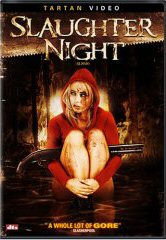
Merging the aesthetic pleasures of the occult with the more disturbing, intimate apprehensions of madness and immediate physical danger, Slaughter Night takes the conventions of the traditional Western slasher film and stands it on its head. Employing plot devices and themes from the body count picture and adding to them the sensibilities of the Italian Giallo, this terrifying experience then seasons the whole story with shades of atmospheric gothic-type style. The result is nothing less than a hot wired rush into the darkness. A darkness that bleeds over a central character whose grief and passion for redemption mistakenly give life to a spectral wrath waiting below a mineshaft.
Despite good intentions and a solid love for one another, Kristel and her father misunderstand each other, viewing the world from the varied vantage points of youth and experience. After one particularly nasty argument over a trip she intends to take, a car wreck leaves the father dead and Kristel psychologically wounded. Weakened by guilt, exhaustion, and fear, Kristel brings some close friends along on a search for papers her father was working on before his death. This is located in a deserted, appropriately creepy mine, whose atmospheric menace adds further character to creepy events. As the characters are further explored and typical adolescent hijacks enjoyed, their weathered old tour-guide explains the haunted, tragic history of the mine, delighting in explaining how before the death sentence was revoked in the Netherlands, convicted felons were used to set off gas explosions in mines. Andries Martiens was the last man to die this way. A murderer of children and sorcerer trying to discover where his deceased parents hid their fortune by travelling into Hell itself, this psychopath's madness was thoroughly documented by Kristel's father, who was a studying eighteenth and nineteenth century serial killers when he died. When they play with a spirit board, they summon the killer's angry spirit and a night of possession, betrayal, and gory death ensues.
While Slaughter Night follows well established genre logic and formula, it also exhibits several traces of surface and thematic originality, most notably its mingling of history and the occult with a Hostel-era glorification of violence. Pacing is also varied, going from a stealthy first half that suddenly erupts into a break-neck speed and gory spectacle reminiscent of the Evil Dead pictures. Directors/writers Frank Van Geloven and Edwin Visser embrace (and understand the value of) atmosphere, as is evident in their physical bleakness and the filthy, seeping, tragic aura that surrounds the characters. In this, the film is superior in both tone and story to the typical kill films that defined so many of the Slasher hybrids upon which this is partially based. Panic and pathos are displayed in equal measure, and while a minimal budget obviously cheapens the technical savvy of the features, it does nothing to distract from the enjoyment of the story, focusing as much on Kristel's characterization and internal motivations as inspired moments of graphic butchery. The shade of Andries hangs heavy over the action, as it should, lending a threat both immediate/physical and cosmic, rooted as he is with a malignant past. The past also plays a crucial role in Kristel's development, with the rocky relationship between her and her father leading her to actual physical danger. The deterioration of friendships is also a key theme, lending further despair to the action. A feast of flashy, grim visuals and a suspenseful, sometimes shocking story, this is a modern slasher that devotes itself as equally to the necessity of story as on-screen carnage. Both graphic and moody, this Dutch film spills blood one moment and shadows the next, honoring both what is seen and what is felt.
Slaughter Night is presented in clear and sharply defined anamorphic widescreen. No grain or scratches are apparent, and colors are clear and bleeding with attitude. Audio is featured in Dolby Digital 5.1 in original Dutch language with optional English and Spanish subtitles. This track does its job without any difficulties. Extras are confined to a handful of Trailers for other Tartan product, the Feature Trailer, some Outtakes, and "The Making of Slaughter Night." The Outtakes are interesting to note but hardly essential, left out for good reason. The 'Making Of' piece is informative if not unique, going into the usual moments of production and moments with cast and crew.
Review by William P. Simmons
| Released by Tartan USA |
| Region 1 - NTSC |
| Not Rated |
| Extras : |
| see main review |